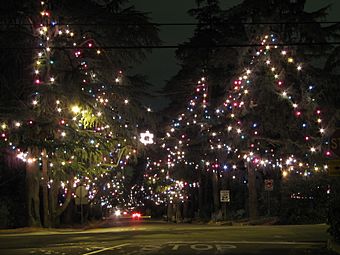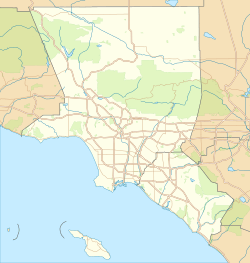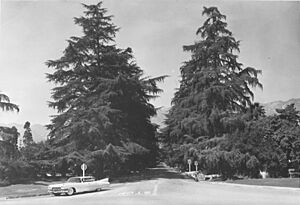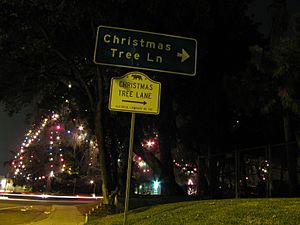Christmas Tree Lane facts for kids
Quick facts for kids |
|
|
Christmas Tree Lane (Via dell'Albero di Natale)
|
|

Christmas Tree Lane, view looking south down Santa Rosa Avenue from Altadena Drive
|
|
| Location | Santa Rosa Ave. between Altadena Drive and Woodbury Road Altadena, California |
|---|---|
| Area | 9.6 acres (3.9 ha) |
| Built | 1885 |
| NRHP reference No. | 90001444 |
| Added to NRHP | September 13, 1990 |
Christmas Tree Lane (which means Via dell'Albero di Natale in Italian) is a special street in Altadena, California. It's about 0.7 miles long and lined with beautiful deodar cedar trees. These trees have been lit up every year for Christmas since 1920.
The group that takes care of the Lane says it's "the oldest large-scale outdoor Christmas display in the world." In 1990, Christmas Tree Lane was added to the U.S. National Register of Historic Places. It also became California Historical Landmark No. 990 that same year.
Contents
History of Christmas Tree Lane
How the Trees Were Planted
Santa Rosa Avenue in Altadena is one of many streets named after female Spanish saints. John P. Woodbury, who helped start Altadena, planned to build a large house at the top of Santa Rosa Avenue. In 1883, he came back from a trip to Italy with seeds from impressive deodar cedar trees. These trees are also known as the "Tree of God" and come from the Himalayas.
John talked to a friend who worked with trees at the Department of Agriculture. His friend said the trees would grow well in Southern California. So, John's brother, Frederick, planted the seeds in a nursery behind his house. Two years later, in 1885, about 150 young trees were moved and planted along Santa Rosa Avenue.
Frederick's ranch foreman, Tom Hoag, led the work. A large group of Chinese workers helped plant the trees. They also built the river-rock-lined gutters, which are still an important part of the Lane's look today. John Woodbury's mansion was never built because of a land problem in 1888. But the deodar trees on Santa Rosa Avenue grew big and strong over the years.
Early Car Races on the Lane
From 1906 to 1909, Santa Rosa Avenue was part of the Pasadena-Altadena Uphill Race. This was a popular sport for the new, fast cars of that time. Famous race cars like the Stutz Bearcat and Barney Oldfield's Ford No. 999 competed.
Racers would start on Los Robles Avenue, turn sharply onto Santa Rosa, and race uphill. The dirt roads were rough. Once, a female passenger was thrown from a car. After that, women were not allowed to ride during the races. These car races only happened for four years.
Lighting Up the Lane for Christmas
In 1920, Frederick Nash, a merchant from Pasadena and a resident of Altadena, had an idea. He was the president of the Pasadena Kiwanis club. He convinced his fellow Kiwanis members and the City of Pasadena to light up the Santa Rosa deodar trees for Christmas. The trees were 35 years old by then.
That first year, they managed to light up a quarter of the Lane. Over the next few years, more lights were added. More and more people came to see the display, often driving their cars slowly between the glowing rows of trees. People started calling the Lane the "Avenue of the Deodars."
In 1927, the Altadena chapter of Kiwanis was formed. Every year, they would take children from the local Boys and Girls Aid Society for rides along the Lane. They called it "Christmas Tree Street."
Christmas Tree Lane During War Times
The Lane was fully lit every year until 1943. Tom Hoag, the old foreman who helped plant the trees, would "pull the switch" to turn on the lights each year. In 1943, the Lane was not lit. This was not because of the war, but because there was not enough water for power generation that year. So, the lights were kept off to save electricity. Tom Hoag passed away that same year.
During the war and in the years that followed, colorful postcards of the Lane became very popular. These postcards often showed the Lane with its lights and started using the name "Christmas Tree Lane." This is likely how the name became widely known.
Christmas Tree Lane Association
For many years, the city of Pasadena helped light Christmas Tree Lane. But in 1956, Altadena residents voted against becoming part of Pasadena. After this, the City of Pasadena stopped helping to light the Lane.
So, in 1957, the people of Altadena decided to take care of the Lane themselves. They formed the Christmas Tree Lane Association. Lawrence Lamb was their first president. Working with the International Brotherhood of Electrical Workers Local No. 11, they raised money and started lighting the Lane themselves.
Local Boy Scout troops used to help manage traffic. They would block side streets and direct cars up Lake Avenue, then down Santa Rosa through the trees. This practice stopped in the mid-1970s because there were too many cars and new residents who didn't like the detours.
At first, the Association was mostly men because of the hard work needed to string the lights. In 1960, a Women's Auxiliary was formed, led by Lenore Denny. They organized fundraising events throughout the year, like summer picnics, rummage sales, and collecting donations from local businesses. Today, both men and women help with fundraising and the physical work.
By the late 1980s, the Association faced challenges. They hadn't replanted missing trees and struggled to put up the lights each year. They had no savings and were in debt. In 1994, new, younger board members were chosen. They raised money to pay off the debt, plant new trees, and build new electrical lines. The Board is slowly replacing the old light bulbs (which used 11 watts each) with new LED bulbs (which use only 1 watt each and last longer).
Southern California Edison's Role
In 1964, Southern California Edison (a power company) was already helping Christmas Tree Lane by providing free electricity. That year, they installed a permanent power system along the Lane. This system included special boxes at three intersections to handle the increased power needed for the lights on the now huge trees.
Every year, many volunteers would come out to string the trees with electric lines and bulbs. After the holiday season, they would take the lights down. The lines were attached to ropes and pulleys at the top of the trees. The wiring was removed before spring so the trees could grow new branches and avoid damage during pruning.
Edison continued to provide free power until 2000. That's when new rules for power companies changed things.
Christmas Tree Lane Becomes a Landmark
Over time, some of the trees started to get old, sick, or damaged by strong winds. By 1990, 132 of the original 146 trees were still standing. That year, Christmas Tree Lane was added to the National Register of Historic Places. It was also nominated to become a California State Landmark.
State officials were impressed by how the Lane brought together two new inventions: electric lights and automobiles. Because of this, it was officially listed as California State Landmark No. 990.
A special marker at the corner of Woodbury and Alameda Street in Altadena explains its history:
- NO. 990 CHRISTMAS TREE LANE - The 135 Deodar Cedar trees were planted in 1885 by the Woodbury Family, the founders of Altadena. First organized by F.C. Nash in 1920, the 'Mile of Christmas Trees' has been strung with 10,000 lights each holiday season through the efforts of volunteers and the Christmas Tree Lane Association. It is the oldest large-scale Christmas lighting spectacle in Southern California.
Challenges for the Lane's Future
In 2000, new rules for power companies meant that Southern California Edison could no longer maintain the Lane's electrical system or provide free electricity. This meant the system would need to be metered, and the electricity would have to be paid for. Also, the system would need permits and had to meet all current electrical safety rules.
The Los Angeles County Public Works Department said the old electrical system was unsafe. The estimated cost to rewire the whole system was very high. This threatened the long-standing Christmas Tree Lane tradition.
The Board of the Christmas Tree Lane Association asked for help from Los Angeles County Supervisor Michael D. Antonovich. The Department of Public Works helped design a new, safe, and legal electrical system. Supervisor Antonovich provided the $130,000 needed for the installation. Thanks to this help, the Lane was lit up on schedule that year.
Images for kids







